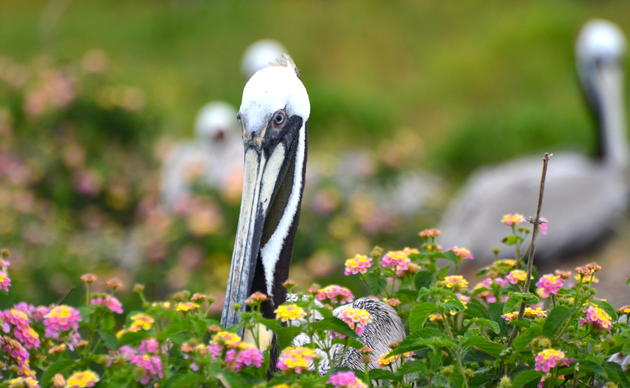Tricolored Heron
A common resident of the coast, the Tricolored Heron breeds mostly in estuarine habitats (salt marshes, mangrove swamps, river deltas, lagoons and salinas) but can also be found using freshwater areas. They are typically found nesting in mixed-species colonies, but small monospecific colonies and solitarily nests have also been observed. Nests are most often found in dense vegetation between 1.5 to 2 m in height and nesting seems to progress through the breeding season from densest vegetation on periphery to sparsest in center of colony. Tricoloreds use a variety of woody vegetation for nesting, including many wetland hardwoods, bald cypress, yucca sp., baccharis, mangroves, buttonwood, willows, wax myrtle, buttonbush, mesquite, huisache, and prickly pear cactus.
Tricolored Herons prefer brackish or salt water for foraging, most often in wetlands in open or semi-open areas up to 18 cm in depth with low vegetation. Foraging habitat varies widely, and the tricolored heron is able to shift foraging behaviors by taking advantage of either flock or solitary foraging strategies. Adults in Florida averaged a foraging radius of 5.6 km around breeding colonies and traveled up to 25 km.
Food supply may be a limiting factor in reproduction. Consistent reduction of broods due to starvation has been recorded, as well as nesting failure in response to interruptions in food availability. Habitat may be another major limiting factor. Along the Atlantic coast, there were significant correlations between coastal breeding abundance and amount of wetland area by state.
For information on Tricolored Herons, including identification tips, visit their page on the Cornell Lab of Ornithology.
Text References
- Hothem, R. L., B. E. Brussee, and W. E. Davis Jr. 2010. Black-crowned Night-Heron (Nycticorax nycticorax).in A. Poole, editor. The Birds of North America Online Cornell Lab of Ornithology, Ithaca.
- Rodgers, J., J. A. 1978. Breeding behavior of the Louisiana Heron. Wilson Bull. 90:45-59.
- Maxwell II, G. R. and H. W. H. W. Kale II. 1977. Breeding biology of five species of herons in coastal Florida. Auk 94:689-700.
- Murdich, W. H. 1978. The feeding ecology of five species of herons in a north-central Florida colony. Master's Thesis. Univ. of Florida, Gainesville.
- Bancroft, G. T., S. D. Jewell, and A. M. Strong. 1990. Foraging and nesting ecology of herons in the lower Everglades relative to water conditions. Final rep. to South Florida Water Manage. District, West Palm Beach.
- Custer, T. W., R. G. Osborn, and W. F. Stout. 1980. Distribution, species abundance, and nesting-site use of Atlantic Coast colonies of herons and their allies. Auk 97:591-600.
How you can help, right now
Join Audubon Texas Today
Becoming a member supports our local work protecting birds and the places they need.
Consider a Legacy Gift for Texas
Planned gifts and bequests allow you to provide a lasting form of support to Audubon Texas.
Subscribe to Our Newsletter
Subscribe to our newsletter for updates about Audubon Texas's conservation work, and news about our activities and local events.




